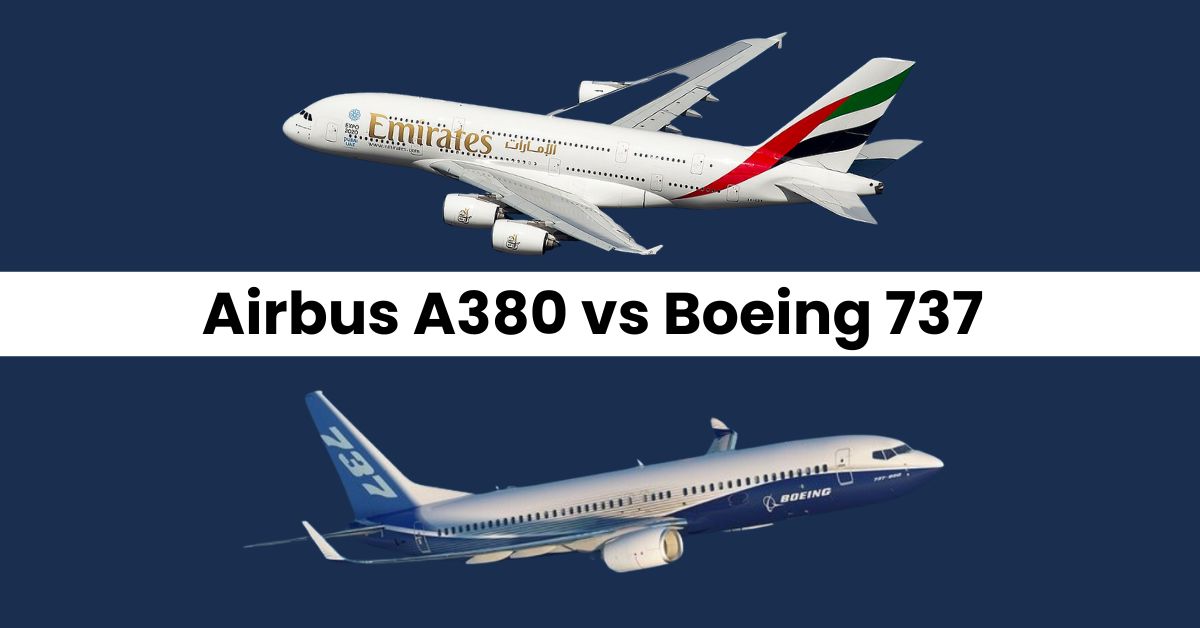In the world of commercial aviation, the Airbus A380 vs Boeing 737 stand out as two of the industry’s most iconic and successful airliners. Each has its unique features, advantages, and uses, catering to different segments of air travel. This article will delve into the key differences and similarities between these two remarkable aircraft, providing insights into which might be considered “better” depending on specific needs and perspectives.
Airbus A380 vs Boeing 737
The Airbus A380 vs Boeing 737 are two iconic aircraft that serve very different purposes in the world of aviation. The Airbus A380, a marvel of engineering, is the world’s largest passenger airliner, designed to carry passengers across continents in unmatched comfort. With its double-deck structure, it can accommodate up to 853 passengers in an all-economy class configuration, making it the go-to choice for high-volume, long-haul flights. It boasts four engines, a massive wing span for stability and efficiency, and a range of up to 8,000 nautical miles. This allows it to connect major cities around the globe without stopping. Check out our comparison of the Airbus A380 vs Boeing 777 to see how they differ.

On the other hand, the Boeing 737, particularly the 737-800 model, is a workhorse of short to medium-haul flights. It’s much smaller than the A380, with a single aisle and a maximum capacity of 189 passengers, but it’s known for its efficiency and versatility. Its two engines and shorter wingspan make it ideal for operating in smaller airports, which is why it’s a favorite among airlines for domestic and regional services. With a range of 3,060 nautical miles, it’s perfectly suited for connecting cities within continents.
| Feature | Airbus A380-800 | Boeing 737-800 |
|---|---|---|
| Country of Origin | France | United States |
| Manufacture Period | 2007 to Present | 1998 to Present |
| ICAO Code | A380 | B738 |
| Price | $445.6 million | $89.2 million |
| Avionics | Thales Rockwell Honeywell Combo | Rockwell Collins avionics |
| Engine | 4x Engine Alliance GP7270 or Rolls-Royce Trent 900 | 2x CFM56-7B27 |
| Engine Type | Turbofan | Turbofan |
| Power | 81,500 pound-force | 27,300 pound-force |
| Max Cruise Speed | 587 knots (1,087 Km/h) | 473 knots (876 Km/h) |
| Travel Range | 8,000 Nautical Miles (14,816 Kilometers) | 3,060 Nautical Miles (5,667 Kilometers) |
| Fuel Economy | 0.1 nm/gal (0.049 km/l) | 0.44 nm/gal (0.215 km/l) |
| Service Ceiling | 43,000 feet | 41,000 feet |
| Rate of Climb | 1500 ft/min | Not specified |
| Take Off Distance | 2749 meter (9,018.92 feet) | 2316 meter (7,598.33 feet) |
| Landing Distance | 1524 meter (4,999.94 feet) | 1372 meter (4,501.26 feet) |
| Max Take Off Weight | 575,000 Kg (1,267,645 lbs) | 384,039 Kg (846,652 lbs) |
| Max Payload | 87,000 Kg (191,800 lbs) | 21,319 Kg (47,000 lbs) |
| Fuel Tank Capacity | 85,472 gallon (323,546 litre) | 6,875 gallon (26,025 litre) |
| Baggage Volume | 190 m³ (6,710 ft³) | 45.1 m³ (1,593 ft³) |
| Seats (Economy) | 853 seats | 189 seats |
| Seats (Business Class) | 480 seats | 175 seats |
| Seats (First Class) | 416 seats | 162 seats |
| Cabin Height | 3 meter (9.84 feet) | 2.2 meter (7.22 feet) |
| Cabin Width | 6.58 meter (21.59 feet) | 3.54 meter (11.61 feet) |
| Cabin Length | 50.68 meter (166.27 feet) | 29.97 meter (98.33 feet) |
| Exterior Length | 72.73 meter (238.61 feet) | 39.5 meter (129.59 feet) |
| Wing Span | 79.75 meter (261.64 feet) | 34.31 meter (112.56 feet) |
| Wing Tips | Wingtip Fences | No Winglets |
Airbus A380

The Airbus A380, or “Superjumbo,” is the largest passenger jet in the world, captivating both travelers and aviation enthusiasts since 2005. This double-decker aircraft, designed to challenge Boeing’s dominance in the large aircraft sector, offers unmatched comfort with the capacity to carry up to 853 passengers. Despite its size, the A380 is known for a quiet cabin and smooth flights. The main model, the A380-800, has been the staple of Airbus’s A380 line. Although Airbus had plans for more variants, like the A380F cargo and a larger A380-900, these were not pursued, leading to the halt of A380 production in 2021. Yet, the A380 continues to be a marvel of modern aviation, serving long-haul routes globally.
Boeing 737
The Boeing 737 is one of the most recognizable and widely used commercial jetliners in the world. Known for its reliability and efficiency, the 737 series has been flying the skies since its first flight in 1967. Over the years, Boeing has introduced various variants of the 737 to meet the evolving needs of the aviation industry, each designed to offer improvements in performance, passenger comfort, and fuel efficiency.

These variants are categorized into several generations, including the Original (737-100 and 737-200), Classic (737-300, -400, -500), Next Generation (737-600, -700, -800, -900), and the latest MAX series (737 MAX 7, MAX 8, MAX 9, MAX 10), which features modern engines and aerodynamic enhancements for better performance and lower operating costs. With thousands of units sold worldwide, the Boeing 737 continues to be a favorite among airlines for its versatility, serving routes ranging from short domestic hops to longer international flights.
Airbus A380 vs Boeing 737 Engines & Fuel
When it comes to the engines and fuel efficiency of the Airbus A380 vs Boeing 737, there’s a notable difference that reflects their distinct roles in aviation. The A380, a giant of the skies, is powered by four massive engines, either the Engine Alliance GP7270 or Rolls-Royce Trent 900, each capable of producing a thrust of 81,500 pounds. This immense power allows the A380 to travel long distances and carry a large number of passengers, but it comes at the cost of fuel efficiency, managing only about 0.1 nautical miles per gallon. It’s designed for long-haul flights where capacity and range are paramount.
On the flip side, the Boeing 737-800 relies on two Snecma/CFM56-7B27 turbofan engines, each providing 27,300 pounds of thrust. This setup yields better fuel economy, achieving approximately 0.44 nautical miles per gallon, which is significantly more efficient than the A380’s rate. The 737’s engines are optimized for short to medium-haul flights, offering a balance of fuel efficiency and power to meet the demands of these routes.
Airbus A380 vs Boeing 737 Pricing
When we look at the pricing between the Airbus A380 and the Boeing 737, the difference is quite significant, reflecting their distinct roles in the aviation industry. The Airbus A380, known as the “Superjumbo,” is the world’s largest passenger airliner and comes with a price tag of about $445.6 million. This hefty price is due to its massive size, advanced technology, and the capacity to carry hundreds of passengers across long distances in unparalleled comfort.
Boeing 737 Price
On the other hand, the Boeing 737, particularly the 737-800 model, is much more modestly priced at around $89.2 million. The Boeing 737 is designed for shorter routes and has a smaller passenger capacity, making it a more economical choice for airlines focusing on domestic or regional services. Its lower price reflects its role as a workhorse of short to medium-haul flights, offering efficiency and versatility without the need for the vast scale and luxury of the A380.
In summary, the Airbus A380’s higher price is justified by its larger size, greater passenger capacity, and longer range, making it suited for major international flights. The Boeing 737, while less expensive, serves a different market segment, excelling in cost-effectiveness for shorter flights with its smaller size and lower operating costs.
Size and Capacity
The most noticeable difference is their size and capacity. The Airbus A380 is a massive plane that can carry between 500 to 853 passengers, depending on how the airline sets it up. It’s designed to move a lot of people from one part of the world to another, all in one go. The Boeing 737, in contrast, is much smaller, with the latest models able to carry up to 230 passengers. It’s the go-to plane for moving people between cities and countries that are closer together.
Range and Efficiency
When it comes to how far they can fly, the A380 can travel up to 8,000 nautical miles without stopping. This means it can easily handle long-haul flights, like from New York to Singapore. The Boeing 737, especially the newer models like the 737 MAX, can fly up to 3,850 nautical miles, which is perfect for shorter international flights or domestic routes.
The A380, with its size, consumes more fuel but is efficient in moving a large number of passengers at once. The 737, being smaller and lighter, is known for its fuel efficiency and flexibility, making it a favorite for airlines operating short to medium-haul routes.
Operating Costs and Versatility
Operating the Airbus A380 is more expensive, not just because of its size but also due to the higher costs associated with landing fees and the need for airports to accommodate its massive structure. The Boeing 737, being smaller and more versatile, can easily operate in a wider range of airports, from small city airports to major international hubs, which keeps its operating costs lower.
Passenger Experience
Passenger experience on the A380 is unmatched, with some airlines offering luxurious amenities like onboard showers and bars. The spacious cabin and smooth ride add to the comfort. The 737, while more utilitarian, has seen significant improvements in passenger comfort, especially in the newer models with upgraded interiors, larger overhead bins, and mood lighting.
Conclusion
The Airbus A380 and Boeing 737 serve very different purposes in the world of aviation. The A380 is a marvel of engineering, designed to transport a large number of passengers across great distances with unparalleled comfort. The Boeing 737, on the other hand, is celebrated for its efficiency, versatility, and role in making air travel accessible to the masses on shorter routes. Both aircraft have made significant impacts on how we fly, each excelling in their respective niches.
FaQs
What are the main differences between the Airbus A380 and Boeing 737?
Can the Airbus A380 fly farther than the Boeing 737?
How many engines do the Airbus A380 and Boeing 737 have?



